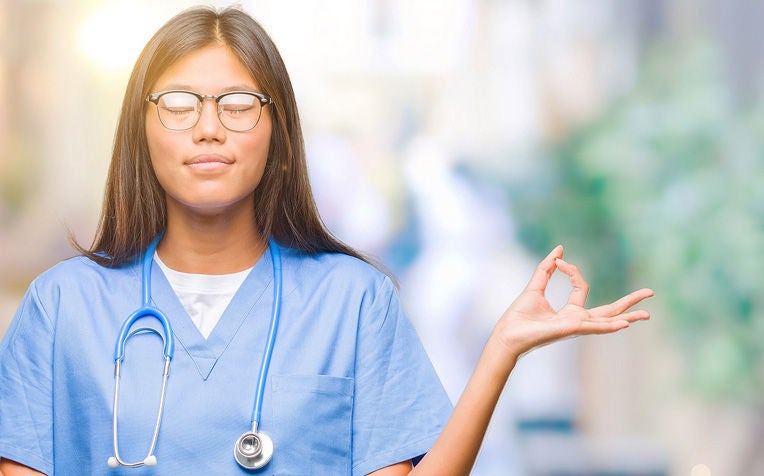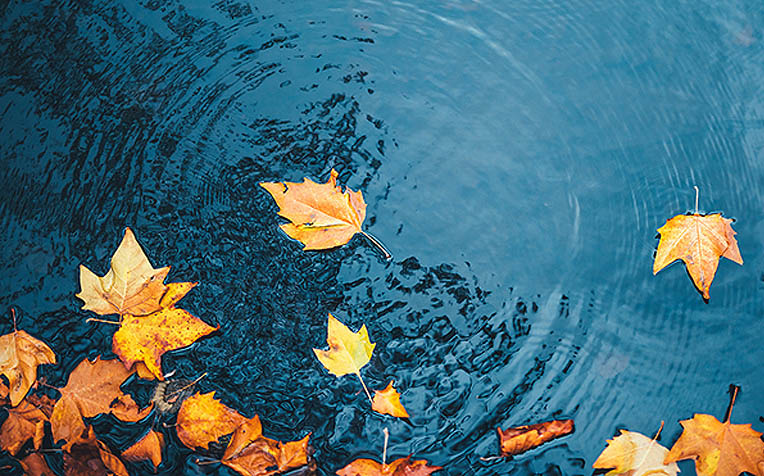
Short relaxation techniques such as deep breathing and counting your breath can be practised virtually anywhere, even at work.
Caring for Yourself
Dedicated to our Healthcare Heroes!
Relaxation
Learning relaxation techniques has many benefits, such as:
◦ Increased energy | ◦ Lowered stress hormone levels and blood pressure |
◦ Increased motivation | ◦ Restoration of sleep |
◦ Improved productivity | |

Relaxation
- Involves a mentally active process that leaves the body relaxed
- Is done in an awake state
- Goal is to be physically relaxed and mentally alert
- Not laying on the sofa/bed, sleeping or not doing anything
General instructions
When?◦ Before/after work ◦ During breaks ◦ Avoid practising after big, heavy meals
| Where?◦ Quiet place at home/work (e.g., break room) ◦ Minimise distractions such as TV or radio
| How?◦ Seated or lying flat on your back ◦ Eyes closed or gazing gently at a distance in front of you ◦ Feet flat on the floor or crossed at the ankles ◦ Hands resting comfortably on your lap |
Do not force yourself to think “I must relax”.
Practise often; first under non-distracting conditions.
Types of relaxation techniques
1. Short relaxation◦ Deep breathing ◦ Counting your breath ◦ Five Minute vacation | 2. Extended relaxation◦ Progressive muscle relaxation ◦ Fantasy Relaxation
|
Short relaxation can be practised in any situation (either at work or at home; while travelling).
Deep breathing

| 5. Hold the breath for 2 counts 6. Release the breath for 5 counts, through your nose 7. When you breathe out, imagine air flowing out of your stomach like a balloon emptying itself. Allow your abdomen to fall back towards your spine 8. Continue for at least 5 minutes |
Counting your breath
| 6. The next time you breathe out, count “two”, and so on up to “five” 7. Then begin a new cycle, counting “one” on the next exhalation 8. Try to concentrate gently on your breathing 9. If your mind wanders away from counting your breath, just re-focus on your breathing and start counting from one again |
Five-minute vacation
1. Start with deep breathing 2. With your eyes closed, imagine your ideal place to relax 3. Try and use your 5 senses to experience this mini vacation in your mind For example: Visualise yourself lying on a white sandy beach, with clear blue skies and gently lapping waves. Imagine your body sinking into the chair and feel the warmth of the sand on your feet. Let go of any tension and continue to breathe with the rhythm of the rolling waves. |  |
Extended relaxation
More suitable to be practised at the end of the day with more time set aside for relaxing. Best to be practised at home or in a quiet place.
What is progressive muscle relaxation?
- Helpful for relieving physical tension
- Physical tension is commonly associated with stress, anxiety and fear
- May not even notice our muscles becoming tense sometimes
- Note: Take caution if you have any injuries or a history of physical problems that may cause muscle pain

Progressive muscle relaxation steps
| 9. Tighten your shoulders as you bring your shoulders up towards your ears 10. Tighten the muscles of your chest by taking in a deep breath. Hold, then relax 11. Tighten your stomach muscles by sucking your stomach in 12. (Don’t do this if you have back pain.) Tighten your lower back by arching it up 13. Tighten your buttocks by pulling them together. Hold, then relax 14. Squeeze the muscles in your thighs 15. Tighten your calf muscles by pulling your toes towards you. Tighten your feet by curling them downwards. Hold, then relax 16. Mentally scan your body for any left over tension. If any muscle group remains tense, repeat the exercise for those muscle groups |
Visualisation
- Focus is on a pleasant image
- Decide where you want to go in your image before starting
- Whatever you choose, try to make it peaceful and calming
- Consider asking someone to read the following slides slowly to you, or to find a similar video on Youtube

Visualisation steps
| 10. To add further detail to this relaxing scene, imagine yourself there. What would you be doing in this calming place? Perhaps you are just sitting, enjoying this place, relaxing. Maybe you imagine walking around or doing any other variety of activities 11. Imagine a feeling of calm and peace in this place where you have no worries, cares, or concerns. A place where you can simply rejuvenate, relax, and enjoy just being 12. Enjoy your peaceful place for a few moments more. Memorize the sights, sounds, and sensations around you. Know that you can return to this place in your mind whenever you need a break, before returning to your regular roles 13. When you are ready to return to your day, file away the imaginary place in your mind, waiting for you the next time you need it 14. Prepare to leave by counting backwards. At 3, become aware of your surroundings (location, people, noises). At 2, move your feet, legs, hands, rotate your head. At 1, open your eyes feeling re-energized, refreshed and relaxed. |
REMEMBER: We cannot avoid stress but we can all develop healthier ways of responding to it!
Up next: Good Sleep Hygiene and You
Ref: L20
Contributed by


















 Get it on Google Play
Get it on Google Play